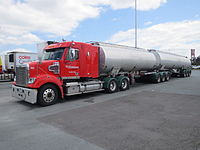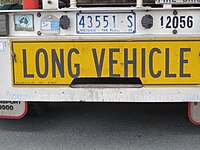Road transport
This articleneeds additional citations forverification.(January 2007) |
| Part of a series on |
| Transport |
|---|
| Modes |
| Topics |
|
|
Road transportorroad transportationis a type of transport usingroads.[1]Transport on roads can be roughly grouped into the transportation of goods and transportation of people. In many countries licensing requirements and safety regulations ensure a separation of the two industries. Movement along roads may be bybike,automobile,bus,truck,or byanimalsuch ashorseoroxen.Standard networks of roads were adopted byRomans,Persians,Aztec,and other earlyempires,and may be regarded as a feature of empires.Cargomay be transported bytrucking companies,while passengers may be transported viamass transit.Commonly defined features of modern roads include definedlanesandsignage.Various classes of road exist, from two-lane local roads with at-gradeintersectionstocontrolled-access highwayswith all cross traffic grade-separated.
The nature of road transportation of goods depends on, apart from the degree of development of the local infrastructure, the distance the goods are transported by road, the weight and volume of an individual shipment, and the type of goods transported. For short distances and light small shipments, avanorpickup truckmay be used. For large shipments even if less than a full truckload a truck is more appropriate. (Also see Trucking and Hauling below). In some countriescargois transported by road in horse-drawn carriages, donkeycartsor other non-motorized mode. Delivery services are sometimes considered a separate category from cargo transport. In many places, fast food is transported on roads by various types ofvehicles.For inner city delivery of small packages and documentsbike couriersare quite common.
People are transported on roads. Special modes of individual transport by road such ascycle rickshawsmay also be locally available. There are also specialist modes of road transport for particular situations, such as ambulances.
History
[edit]Early roads
[edit]
The first methods of road transport werehorses,oxenor even humans carrying goods overdirt tracksthat often followedgametrail.ThePersianslater built a network ofRoyal Roadsacross their empire.
With the advent of theRoman Empire,there was a need for armies to be able to travel quickly from one region to another, and the roads that existed were often muddy, which greatly delayed the movement oflarge masses of troops.To resolve this issue, the Romans built solid and lasting roads. TheRoman roadsused deep roadbeds of crushed stone as an underlying layer to ensure that they kept dry, as the water would flow out from the crushed stone, instead of becoming mud in clay soils. The IslamicCaliphatelater builttar-pavedroads inBaghdad.[2]
New road networks
[edit]As states developed and became richer, especially with theRenaissance,new roads and bridges began to be built, often based on Roman designs. Although there were attempts to rediscover Roman methods, there was little useful innovation in road building before the 18th century.

Starting in the early 18th century, theBritish Parliamentbegan to pass a series ofactsthat gave the local justices powers to erect toll-gates on the roads, in exchange for professional upkeep.[3][4]The toll-gate erected at Wade's Mill became the first effective toll-gate in England. The first scheme that had trustees who were not justices was established through a turnpike act[which?]in 1707, for a section of the London-Chesterroad between Foothill andStony Stafford.The basic principle was that the trustees would manage resources from the several parishes through which the highway passed, augment this with tolls from users from outside the parishes and apply the whole to the maintenance of the main highway. This became the pattern for the turnpiking of a growing number of highways, sought by those who wished to improve flow of commerce through their part of a county.[3]
In 18th centuryWest Africa,road transport throughout theAshanti Empirewas maintained via anetwork of well-kept roadsthat connected the Ashanti capital with territories within its jurisdiction and influence.[5][6]After significant road construction undertaken by the kingdom ofDahomey,toll roadswere established with the function of collecting yearly taxes based on the goods carried by the people of Dahomey and their occupation.[7]The Royal Road was built in the late 18th century by KingKpenglawhich stretched fromAbomeythroughCanaup toOuidah.[8]
The quality of early turnpike roads was varied.[9]Although turnpiking did result in some improvement to each highway, the technologies used to deal with geological features, drainage, and the effects of weather were all in their infancy.Road constructionimproved slowly, initially through the efforts of individual surveyors such asJohn MetcalfinYorkshirein the 1760s.[10]British turnpike builders began to realize the importance of selecting clean stones for surfacing while excluding vegetable material and clay, resulting in more durable roads.[11][12]
Industrial civil engineering
[edit]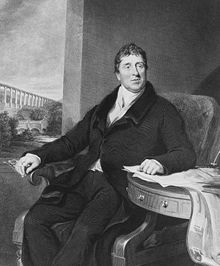
By the late 18th and early 19th centuries, new methods of highway construction had been pioneered by the work of three British engineers,John Metcalf,Thomas TelfordandJohn Loudon McAdam,and by the French road engineerPierre-Marie-Jérôme Trésaguet.
The first professional road builder to emerge during theIndustrial RevolutionwasJohn Metcalf,who constructed about 180 miles (290 km) ofturnpike road,mainly in the north of England, from 1765. He believed a good road should have good foundations, be well drained and have a smoothconvexsurface to allowrainwaterto drain quickly into ditches at the side. He understood the importance of good drainage, knowing it was rain that caused most problems on the roads.
Pierre-Marie-Jérôme Trésaguetestablished the firstscientific approachtoroad buildingin France at the same time. He wrote a memorandum on his method in 1775, which became general practice in France. It involved a layer of large rocks, covered by a layer of smaller gravel. The lower layer improved on Roman practice in that it was based on the understanding that the purpose of this layer (the sub-base orbase course) is to transfer the weight of the road and its traffic to the ground, while protecting the ground from deformation by spreading the weight evenly. Therefore, the sub-base did not have to be a self-supporting structure. The upper running surface provided a smooth surface for vehicles while protecting the large stones of the sub-base.
The surveyor and engineerThomas Telfordalso made substantial advances in the engineering of new roads and the construction of bridges. His method of road building involved the digging of a large trench in which a foundation of heavy rock was set. He also designed his roads so that they sloped downwards from the centre, allowing drainage to take place, a major improvement on the work of Trésaguet. The surface of his roads consisted of broken stone. He also improved on methods for the building of roads by improving the selection of stone based on thickness, taking into account traffic, alignment and slopes. During his later years, Telford was responsible for rebuilding sections of theLondon to Holyhead road,a task completed by his assistant of ten years,John MacNeill.[13]
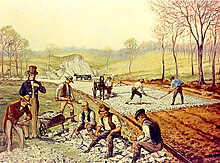
It was another Scottish engineer,John Loudon McAdam,who designed the first modern roads. He developed an inexpensive paving material of soil and stone aggregate (known asmacadam). His road building method was simpler than Telford's, yet more effective at protecting roadways: he discovered that massive foundations of rock upon rock were unnecessary, and asserted that native soil alone would support the road and traffic upon it, as long as it was covered by a road crust that would protect the soil underneath from water and wear.[15]
Also unlike Telford and other road builders, McAdam laid his roads as level as possible. His 30-foot-wide (9 m) road required only a rise of three inches from the edges to the center. Cambering and elevation of the road above the water table enabled rainwater to run off into ditches on either side.[16]Size of stones was central to the McAdam's road building theory. The lower 200-millimetre (8 in) road thickness was restricted to stones no larger than 75 millimetres (3.0 in). The upper 50-millimetre (2 in) layer of stones was limited to 20 millimetres (1 in) size and stones were checked by supervisors who carried scales. A workman could check the stone size himself by seeing if the stone would fit into his mouth. The importance of the 20 mm stone size was that the stones needed to be much smaller than the 100 mm width of the ironcarriagetyresthat traveled on the road. Macadam roads were being built widely in the United States and Australia in the 1820s and in Europe in the 1830s and 1840s.[17]
20th century
[edit]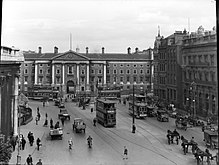
Macadam roads were adequate for use by horses and carriages or coaches, but they were very dusty and subject to erosion with heavy rain. TheGood Roads Movementoccurred in the United States between the late 1870s and the 1920s. Advocates for improved roads led by bicyclists turned local agitation into a national political movement.
Outside cities, roads were dirt or gravel; mud in the winter and dust in the summer. Early organizers cited Europe whereroad constructionand maintenance was supported by national and local governments. In its early years, the main goal of the movement was education for road building inrural areasbetween cities and to help rural populations gain the social and economic benefits enjoyed by cities where citizens benefited from railroads, trolleys and paved streets. Even more than traditional vehicles, the newly invented bicycles could benefit from good country roads. Later on, they did not hold up to higher-speed motor vehicle use. Methods to stabilisemacadam roadswith tar date back to at least 1834 when John Henry Cassell, operating fromCassell's Patent Lava Stone WorksinMillwall,patented "Pitch Macadam".[18] This method involved spreading tar on thesubgrade,placing a typical macadam layer, and finally sealing the macadam with a mixture of tar and sand. Tar-grouted macadam was in use well before 1900 and involved scarifying the surface of an existing macadam pavement, spreading tar, and re-compacting. Although the use of tar in road construction was known in the 19th century, it was little used and was not introduced on a large scale until the motorcar arrived on the scene in the early 20th century.
Modern tarmac was patented by British civil engineerEdgar Purnell Hooley,who noticed that spilled tar on the roadway kept the dust down and created a smooth surface.[19]He took out a patent in 1901 for tarmac.[20]Hooley's 1901 patent involved mechanically mi xing tar and aggregate prior to lay-down and then compacting the mixture with asteamroller.The tar was modified by adding small amounts ofPortland cement,resin,andpitch.[21]

The first version of moderncontrolled-access highwaysevolved during the first half of the 20th century. TheLong Island Motor ParkwayonLong Island,New York,opened in 1908 as a private venture, was the world's first limited-access roadway. It included many modern features, includingbanked turns,guard railsand reinforced concretetarmac.[24]Traffic could turn left between the parkway and connectors, crossing oncoming traffic, so it was not a controlled-access highway (or "freeway" as later defined by the federal government'sManual on Uniform Traffic Control Devices).
Modern controlled-access highways originated in the early 1920s in response to the rapidly increasing use of theautomobile,the demand for faster movement between cities and as a consequence of improvements in paving processes, techniques and materials. These original high-speed roads were referred to as "dual highways"and have been modernized and are still in use today.
Italy was the first country in the world to build controlled-access highways reserved for fast traffic and for motor vehicles only.[22][23]TheAutostrada dei Laghi( "Lakes Motorway" ), the first built in the world, connectingMilantoLake ComoandLake Maggiore,and now parts of theA8andA9motorways, was devised byPiero Puricelliand was inaugurated in 1924.[23]This motorway, calledautostrada,contained only one lane in each direction and no interchanges. The Bronx River Parkway was the first road in North America to utilize a median strip to separate the opposing lanes, to be constructed through a park and where intersecting streets crossed over bridges.[25][26]TheSouthern State Parkwayopened in 1927, while theLong Island Motor Parkwaywas closed in 1937 and replaced by theNorthern State Parkway(opened 1931) and the contiguousGrand Central Parkway(opened 1936). In Germany, construction of theBonn-Cologne Autobahnbegan in 1929 and was opened in 1932 byKonrad Adenauer,then the mayor ofCologne.
In Canada, the first precursor with semi-controlled access wasThe Middle RoadbetweenHamiltonandToronto,which featured a median divider between opposing traffic flow, as well as the nation's firstcloverleaf interchange.This highway developed into theQueen Elizabeth Way,which featured a cloverleaf and trumpet interchange when it opened in 1937 and until theSecond World Warboasted the longest illuminated stretch of roadway built.[27]A decade later, the first section ofHighway 401was opened, based on earlier designs. It has since become North America's busiest highway.
The wordfreewaywas first used in February 1930 byEdward M. Bassett.[28][29][30]Bassett argued that roads should be classified into three basic types: highways,parkways,and freeways.[30]In Bassett'szoningandproperty law-based system,abutting property ownershave the rights oflight,airand access to highways but to not parkways and freeways; the latter two are distinguished in that the purpose of a parkway is recreation, while the purpose of a freeway is movement.[30]Thus as originally conceived, a freeway is a strip of public land devoted to movement to which abutting property owners do not have rights of light, air or access.[30]
Trucking and haulage
[edit]

Trucking companies (inAmerican Englishterminology) or haulage companies / hauliers (in British English) acceptcargofor road transport.Truck driversoperate either independently – working directly for the client – or through freight carriers or shipping agents. Some big companies (e.g. grocery store chains) operate their own internal trucking operations. The market size for general freight trucking was nearly $125 billion in 2010.
In the U.S. many truckers own theirtruck(rig), and are known asowner-operators.Some road transportation is done on regular routes or for only oneconsigneeper run (full truckload), while others transport goods from many different loading stations/shippers to various consignees per run (less-than-truckload). On some long runs only cargo for one leg of the route (to) is known when the cargo is loaded. Truckers may have to wait at the destination for abackhaul.[31]
Abill of ladingissued by the shipper provides the basic document for road freight. On cross-bordertransportation the trucker will present the cargo and documentation provided by the shipper tocustomsfor inspection (for EC see alsoSchengen Agreement). This also applies to shipments that are transported out of afree port.[32]
Hours of service
[edit]To avoid accidents caused by fatigue, truckers have to adhere to strict rules for drive time and required rest periods. In the United States and Canada, these regulations are known ashours of service,and in the European Union asdrivers working hours.One such regulation is theHours of Work and Rest Periods (Road Transport) Convention, 1979.[33]TachographsorElectronic on-board recordersrecord the times the vehicle is in motion and stopped. Some companies use two drivers per truck to ensure uninterrupted transportation; with one driver resting or sleeping in a bunk in the back of the cab while the other is driving.
Licenses
[edit]Truck drivers often need special licenses to drive, known in the U.S. as acommercial driver's license.In the U.K. alarge goods vehiclelicence is required. For transport of hazardous materials (seedangerous goods) truckers need a licence, which usually requires them to pass an exam (e.g. in the EU). They have to make sure they affix proper labels for the respective hazard(s) to their vehicle. Liquid goods are transported by road intank trucks(in American English) or tanker lorries (in British English) (also road-tankers) or special tank containers forintermodal transport.For transportation of live animals special requirements have to be met in many countries to prevent cruelty to animals (seeanimal rights). For fresh and frozen goodsrefrigerator trucksorreefersare used.
Weights
[edit]Some loads are weighed at the point of origin and the driver is responsible for ensuringweightsconform to maximum allowed standards. This may involve using on-board weight gauges (load pressure gauges), knowing the empty weight of the transport vehicle and the weight of the load, or using a commercial weight scale.[34]In routeweigh stationscheck that gross vehicle weights do not exceed the maximum weight for that particular jurisdiction and will include individual axle weights. This varies by country, states within a country, and may include federal standards. TheUnited StatesusesFMCSA federal standardsthat includebridge lawformulas.Many states, not on the national road system, use their own road and bridge standards.[35]Enforcement scales may include portable scales, scale houses with low speed scales orweigh-in-motion(WIM) scales.
TheEuropean Unionuses theInternational Recommendation,OIML R 134-2 (2009). The process may involve a scale house and low-speed scales or higher-speed WIM road or bridge scales with the goal of public safety, as well as road and bridge safety, according to theBridges Act.[36]
Modern roads
[edit]
Today, roadways are primarilyasphaltorconcrete.Both are based on McAdam's concept of stone aggregate in a binder, asphalt cement orPortland cementrespectively. Asphalt is known as a flexiblepavement,one which slowly will "flow" under the pounding of traffic. Concrete is a rigid pavement, which can take heavier loads but is more expensive and requires more carefully prepared subbase. So, generally, major roads are concrete and local roads are asphalt. Concrete roads are often covered with a thin layer of asphalt to create a wearing surface.
Modern pavements are designed for heavier vehicle loads and faster speeds, requiring thicker slabs and deeper subbase. Subbase is the layer or successive layers of stone, gravel and sand supporting the pavement. It is needed to spread out the slab load bearing on the underlying soil and to conduct away any water getting under the slabs. Water will undermine a pavement over time, so much of pavement and pavement joint design are meant to minimize the amount of water getting and staying under the slabs.
Shoulders are also an integral part of highway design. They are multipurpose; they can provide a margin of side clearance, a refuge for incapacitated vehicles, an emergency lane, and parking space. They also serve a design purpose, and that is to prevent water from percolating into the soil near the main pavement's edge. Shoulder pavement is designed to a lower standard than the pavement in the traveled way and won't hold up as well to traffic, so driving on the shoulder is generally prohibited.
Pavement technology is still evolving, albeit in not easily noticed increments. For instance, chemical additives in the pavement mix make the pavement more weather resistant, grooving and other surface treatments improve resistance to skidding andhydroplaning,and joint seals which were once tar are now made of low maintenance neoprene.
Traffic control
[edit]
Nearly all roadways are built with devices meant to controltraffic.Most notable to the motorist are those meant to communicate directly with the driver. Broadly, these fall into three categories: signs, signals or pavement markings. They help the driver navigate; they assign the right-of-way at intersections; they indicate laws such asspeed limitsand parking regulations; they advise of potential hazards; they indicate passing and no passing zones; and otherwise deliver information and to assure traffic is orderly and safe.
Two hundred years ago these devices were signs, nearly all informal. In the late 19th century signals began to appear in the biggest cities at a few highly congested intersections. They were manually operated, and consisted of semaphores, flags orpaddles,or in some cases colored electric lights, all modeled on railroad signals. In the 20th century signals were automated, at first with electromechanical devices and later with computers. Signals can be quite sophisticated: with vehicle sensors embedded in the pavement, the signal can control and choreograph the turning movements of heavy traffic in the most complex of intersections. In the 1920straffic engineerslearned how to coordinate signals along a thoroughfare to increase its speeds and volumes. In the 1980s, with computers, similar coordination of whole networks became possible.
In the 1920s pavement markings were introduced. Initially they were used to indicate the road's centerline. Soon after they were coded with information to aid motorists in passing safely. Later, with multi-lane roads they were used to definelanes.Other uses, such as indicating permitted turning movements and pedestrian crossings soon followed.
In the 20th century traffic control devices were standardized. Before then every locality decided on what its devices would look like and where they would be applied. This could be confusing, especially to traffic from outside the locality. In the United States standardization was first taken at the state level, and late in the century at the federal level. Each country has a Manual of Uniform Traffic Control Devices (MUTCD) and there are efforts to blend them into a worldwide standard.
Besides signals, signs, and markings, other forms of traffic control are designed and built into the roadway. For instance, curbs and rumble strips can be used to keep traffic in a given lane and median barriers can prevent left turns and even U-turns.
Toll roads
[edit]The examples and perspective in this sectiondeal primarily with the United States and do not represent aworldwide viewof the subject.(November 2021) |

Earlytoll roadswere usually built by private companies under a government franchise. They typically paralleled or replaced routes already with some volume of commerce, hoping the improved road would divert enough traffic to make the enterprise profitable. Plank roads were particularly attractive as they greatly reduced rolling resistance and mitigated the problem of getting mired in mud. Another improvement, better grading to lessen the steepness of the worst stretches, allowed draft animals to haul heavier loads.
Atoll roadin the United States is often called aturnpike.The termturnpikeprobably originated from the gate, often a simple pike, which blocked passage until the fare was paid at atoll house(ortoll boothin current terminology). When the toll was paid the pike, which was mounted on a swivel, was turned to allow the vehicle to pass. Tolls were usually based on the type of cargo being transported, not the type of vehicle. The practice of selecting routes so as to avoid tolls is calledshunpiking.This may be simply to avoid the expense, as a form of economic protest (orboycott), or simply to seek a road less traveled as a bucolic interlude.
Companies were formed to build, improve, and maintain a particular section of roadway, and tolls were collected from users to finance the enterprise. The enterprise was usually named to indicate the locale of its roadway, often including the name of one of both of the termini. The wordturnpikecame into common use in the names of these roadways and companies, and is essentially used interchangeably withtoll roadin current terminology.
In theUnited States,toll roads began with theLancaster Turnpikein the 1790s, withinPennsylvania,connectingPhiladelphiaandLancaster.In the state ofNew York,theGreat Western Turnpikewas started inAlbanyin 1799 and eventually extended, by several alternate routes, to near what is nowSyracuse, New York.
Toll roads peaked in the mid 19th century, and by the turn of the twentieth century most toll roads were taken over by state highway departments. The demise of this early toll road era was due to the rise of canals and railroads, which were more efficient (and thus cheaper) in moving freight over long distances. Roads wouldn't again be competitive with rails and barges until the first half of the 20th century when the internal combustion engine replaces draft animals as the source of motive power.
With the development, mass production, and popular embrace of the automobile, faster and higher capacity roads were needed. In the 1920s limited access highways appeared. Their main characteristics were dual roadways with access points limited to (but not always) grade-separated interchanges. Their dual roadways allowed high volumes oftraffic,the need for no or fewtraffic lightsalong with relatively gentle grades and curves allowed higher speeds.
The first limited access highways wereParkways,so called because of their often park-likelandscapingand, in the metropolitanNew York Cityarea, they connected the region's system of parks. When theGerman autobahnsbuilt in the 1930s introduced higher design standards and speeds, road planners and road-builders in the United States started developing and building toll roads to similar high standards. ThePennsylvania Turnpike,which largely followed the path of a partially built railroad, was the first, opening in 1940.
After 1940 with thePennsylvania Turnpike,toll roads saw a resurgence, this time to fund limited access highways. In the late 1940s and early 1950s, afterWorld War IIinterrupted the evolution of the highway, the US resumed building toll roads. They were to still higher standards and one road, theNew York State Thruway,had standards that became the prototype for theU.S. Interstate Highway System.Several other major toll-roads which connected with the Pennsylvania Turnpike were established before the creation of the Interstate Highway System. These were theIndiana Toll Road,Ohio Turnpike,andNew Jersey Turnpike.
Interstate Highway System
[edit]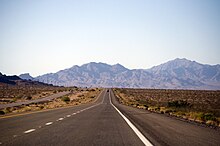
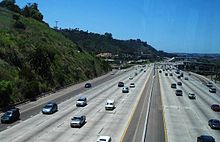
In the United States, beginning in 1956, Dwight D. Eisenhower National System of Interstate and Defense Highways, commonly called theInterstate Highway Systemwas built. It uses 12 foot (3.65m) lanes, widemedians,a maximum of 4%grade,and full access control, though many sections don't meet these standards due to older construction or constraints. This system created a continental-sized network meant to connect every population center of 50,000 people or more.
By 1956, most limited access highways in the eastern United States were toll roads. In that year, theFederal Aid Highway Act of 1956was passed, funding non-toll roads with 90% federal dollars and 10% state match, giving little incentive for states to expand their turnpike system. Funding rules initially restricted collections of tolls on newly funded roadways, bridges, and tunnels. In some situations, expansion or rebuilding of a toll facility using Interstate Highway Program funding resulted in the removal of existing tolls. This occurred inVirginiaonInterstate 64at theHampton Roads Bridge-Tunnelwhen a second parallel roadway to the regional 1958bridge-tunnelwas completed in 1976.
Since the completion of the initial portion of the Interstate Highway System, regulations were changed, and portions of toll facilities have been added to the system. Some states are again looking at toll financing for new roads and maintenance, to supplement limited federal funding. In some areas, new road projects have been completed withpublic-private partnershipsfunded by tolls, such as thePocahontas Parkway(I-895) nearRichmond, Virginia.
The newest policy passed by Congress and the Obama administration regarding highways is theSurface and Air Transportation Programs Extension Act of 2011.
Pneumatic tyres
[edit]
As the horse-drawncarriagewas replaced by thecar,busand lorry ortruck,and speeds increased, the need for smoother roads and less vertical displacement became more apparent, and pneumatictyreswere developed to decrease the apparent roughness.Wagonand carriagewheels,made ofwood,had a tyre in the form of anironstrip that kept the wheel from wearing out quickly. Pneumatic tyres, which had a larger footprint than iron tyres, also were less likely to get bogged down in themudon unpaved roads.
See also
[edit]- National Highway System (USA)
- Passenger vehicles in the USA
- Transportation in the United States
- National Transportation Safety Board
- German autobahns
- Glossary of road transport terms
- Neo-bulk cargo
- Public transport
- Traffic congestion
- Transportation forecasting
- Transport engineering
- List of roads and highways
 Transport portal
Transport portal- Portal:Transport/Trucking media
- Portal:Transport/Highway media
Bibliography
[edit]- Lay, M. G. (1992).Ways of the World: A History of the World's Roads and of the Vehicles That Used Them.Sydney: Primavera Press.ISBN1-875368-05-1.
References
[edit]- ^"What is 'Road Transport'".The Economic Times.Retrieved2024-03-15.
- ^"Road Transportation – A History and How We Use it Today".American Auto Move. 30 August 2012.Archivedfrom the original on 9 September 2013.Retrieved12 September2012.
- ^abWebb. English Local Government. pp. 157-159
- ^Statute15 Cha. 2.c. 1.
- ^Thornton, John Kelly(1999).Warfare in Atlantic Africa, 1500-1800.Routledge.p. 73.ISBN9781135365844.Archivedfrom the original on 2023-04-11.Retrieved2023-02-22.
- ^Eisenstadt, Shmuel Noah.;Abitbol, Michael;Chazan, Naomi(1988).The Early State in African Perspective: Culture, Power, and Division of Labor.Brill.p. 86.ISBN9004083553.
- ^Herskovits, Melville J. (1967).Dahomey: An Ancient West African Kingdom(Volume I ed.). Evanston, IL: Northwestern University Press.
- ^Alpern, Stanley B. (1999). "Dahomey's Royal Road".History in Africa.26:11–24.doi:10.2307/3172135.JSTOR3172135.S2CID161238713.
- ^Parliamentary Papers,1840, Vol 256 xxvii.
- ^The Turnpike TrustArchived2014-05-25 at theWayback MachineSchools History.org, Accessed July 2011
- ^Lay 1992,p. 72.
- ^Oxford, Robert (3 September 2003)."How old is that route?"(PDF).Institution of Civil Engineers.Archived fromthe original(PDF)on 27 September 2007.Retrieved2007-01-19.
- ^Bellis, Mary (2007)."Thomas Telford".About: inventors.About, Inc,New York Times.Archived fromthe originalon June 30, 2012.Retrieved2007-01-19.
- ^"1823 - First American Macadam Road"(Painting -Carl Rakeman)US Department of Transportation - Federal Highway Administration (Accessed 2008-10-10)
- ^Craig, David,"The Colossus of Roads",Palimpsest,Strum.co.uk,archivedfrom the original on 14 November 2020,retrieved18 June2010
- ^McAdam (1824), p.38
- ^Lay 1992,p. 83.
- ^From: 'Northern Millwall: Tooke Town', Survey of London: volumes 43 and 44: Poplar, Blackwall and Isle of Dogs (1994), pp. 423-433Archived2014-01-16 at theWayback MachineDate accessed: 24 May 2009
- ^Ralph Morton (2002),Construction UK: Introduction to the Industry,Oxford: Blackwell Science, p. 51,ISBN0-632-05852-8,retrieved22 June2010.(Details of this story vary a bit, but the essence of is the same, as are the basic facts).
- ^Harrison, Ian (2004),The Book of Inventions,Washington, DC:National Geographic Society,p. 277,ISBN978-0-7922-8296-9,archivedfrom the original on 9 September 2021,retrieved23 June2010
- ^Hooley, E. Purnell,U.S. patent 765,975,"Apparatus for the preparation of tar macadam", July 26, 1904
- ^abLenarduzzi, Thea (30 January 2016)."The motorway that built Italy: Piero Puricelli's masterpiece".The Independent.Retrieved12 May2022.
- ^abc"The" Milano-Laghi "by Piero Puricelli, the first motorway in the world".Retrieved10 May2022.
- ^Patton, Phil (9 October 2008). "A 100-Year-Old Dream: A Road Just for Cars".The New York Times.
- ^"Built to Meander, Parkway Fights to Keep Measured Pace".The New York Times.6 June 1995.Archivedfrom the original on 14 May 2013.Retrieved13 April2010.
- ^Hershenson, Roberta (18 June 1995)."Bronx River Parkway on an Endangered List".The New York Times.Archivedfrom the original on 14 May 2013.Retrieved13 April2010.
- ^Shragge, John & Bagnato, Sharon (1984).From Footpaths to Freeways.Ontario Ministry of Transportation and Communications, Historical Committee. p. 55.ISBN978-0-7743-9388-1.
- ^Karnes, Thomas L. (2009).Asphalt and Politics: A History of the American Highway System.Jefferson, NC: McFarland & Co. p.131.ISBN9780786442829.
- ^Korr, Jeremy (2008)."Physical and Social Constructions of the Capital Beltway".In Mauch, Christof & Zeller, Thomas (eds.).The World Beyond the Windshield: Roads and Landscapes in the United States and Europe.Athens: Ohio University Press. p. 195.ISBN9780821417676.
- ^abcdBassett, Edward M. (February 1930). "The Freeway: A New Kind of Thoroughfare".American City.42:95.
- ^Brown, Dennis."What is a backhaul?".Freight Broker Bootcamp.Archivedfrom the original on 22 December 2019.Retrieved20 September2018.
- ^Bartsch, Frank (4 June 2013)."Truck freight - nothing easier than".BB Handel.Archivedfrom the original on 12 May 2013.Retrieved8 June2013.
- ^"What do we want to achieve?".European Commission. 19 June 2012. Archived fromthe originalon 15 March 2007.Retrieved11 September2012.
- ^"About CAT Scale".CAT Scale. 4 December 2015.Archivedfrom the original on 20 September 2018.Retrieved20 September2018.
- ^Foxx, Anthony R. (2012-10-01)."Freight Management and Operations".US Department of Transportation Federal Highway Administration.Archivedfrom the original on 2018-06-30.Retrieved20 September2018.
- ^"International Recommendation (OIML R 134-2"(PDF).International Organization of Legal Metrology. 2009.Archived(PDF)from the original on 2014-01-06.Retrieved20 September2018.




